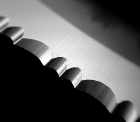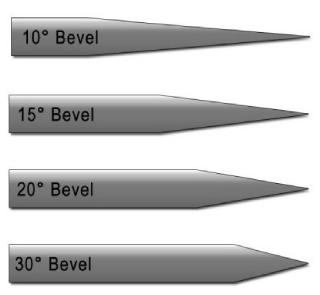
How bevel angle affects sharpness & wear

The issue of sharpness versus durability is a simple enough at first glance. The narrower the angle, the sharper the blade can get. The wider the angle, the more durable the edge is.
So it makes sense that a razor blade is narrower than the blade of an axe. A razor wouldn't hold up to one chop, and an axe will never shave you.
Here are our thoughts on practical use of bevel angles. Please note that we lean toward the conservative side (prefer a wider, more durable angle).
Most knife experts take really good care of their knives so it follows they would prefer sharpness over durability. Our angles are based on the belief that even a well cared for knife needs a fighting chance.
10 Degree Bevel Angle
This is about as flat as a blade can get. A straight razor may dip down to around eight degrees, but that is the limit. An edge with a 10 degree bevel is extremely delicate and not practical for most use.
15 Degree Bevel Angle
A sharpening angle of 15 degrees is still lower than useful for most knives. This edge is typically too weak for any knife that might be used in any type of chopping. If you would rather slice than saw your tomatoes you will probably need a knife about this sharp.
20 Degree Bevel Angle
Most experts agree that a 20 degree angle covers most kitchen knives. We think only the sharpest filet-type knives in the set. We suggest more like 23 degrees for the rest of the set. They will get plenty sharp, and will stay that way longer.
30 Degree Bevel Angle
This is getting into the cleaver to axe range, where chopping and splitting become more the task. The knife edges are considerably more durable.
Contrary to popular belief, a pocket knife or a hunting knife will also fall closely into this range (25 degrees or more). This is because a pocket knife is by its very nature subjected to a rough life.

|







Turn around is usually about two days, but we can usually rush your order if needed. Want to get started? We're ready!